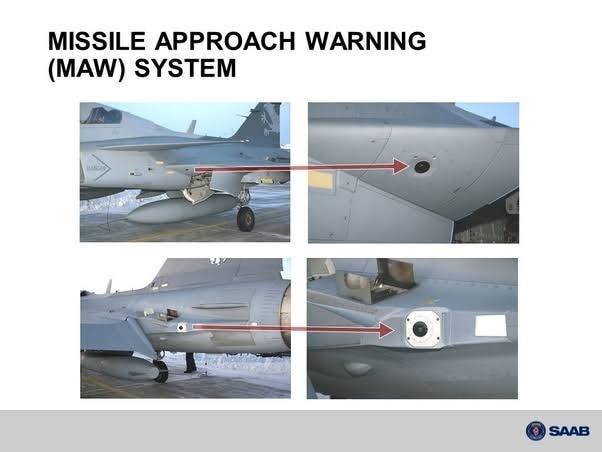Missile approach warning systems are systems integrated with airborne platforms to evade incoming missiles. These systems provide audio video data to pilot, thus increasing his situational awareness to do counter maneuvers or fire electronic counter measures i,e chaffs & flares. Radar warning receivers provides the information about presence of any radiation i.e Air Defense Search & Fire Control Radar, Aircraft’s Radar etc. which guide radar guided missiles i.e SAMs, BVRs etc but for optical guided missiles i.e MANPADs, IR missiles, RWR is obsolete. MAWS were particularly developed for IR missiles, though they can detect all kinds of them.
MAWS are generally used at rear fuselage or tail section of aircraft, they can also provide the “Time to Impact” (TTI) of the approaching missile, thus enabling pilot to decide the counter measure. Many MAWS are even able to track range and direction of fire. They have a few categories depending upon their working techniques and sensors. These systems are proportional to cost. More the power available for the system, more effective MAWS can be integrated.
Following are few types of MCWS available
•Radar Based MAWS.
•Infrared Based MAWS.
•Ultraviolet Based MAWS.
Radar Based MAWS
This category particularly uses Pulse-Doppler radar fitted at the tail of aircraft i.e Euro Fighter Typhoon’s MAWS is provided as reference. Radar based MAWS is active one, thus it relies only on its own radar waves. This can provide distance and speed of the incoming missile, independent of the heat signature of rocket motor of missile, this can be lethal also in bad weather where other systems are not much useful. But these systems being active, are a huge threat to aircraft itself. Their radiations if not carefully set, can synchronize with ground-based radars hence can fall a prey to SAMs especially. When low flying, aircraft can be in range of MANPADs which have max 5km range in general with 2-3 Km no escape zone. MANPADs have a small missile with extremely low Radar Cross Section, thus the TTI (time to impact) will be provided at extreme close range of missile. MANPAD’s range being small provides a small TTI (1 second in no escape zone, 3-5 seconds at max range), in such case, radar-based MAWS will be obsolete to the threat. More-ever this system is also difficult to operate in light-medium weight fighters and helicopters, these systems also require a lot of power from aircraft, hence increasing the overall operational cost.
Infrared Based MAWS
These MAWS use cameras and image processing to detect the incoming missiles, lethal against all sort of missiles as they burn fuel and causes heat signature, can also potentially detect the kinetic heat of missiles due to air drag. In good weather conditions, the atmospheric transmission of IR radiation tends to be better and have longer ranges at high altitude. At low level, these is a huge ground clutter which cause the system to give frequent fire alarms. More-ever it requires a clear weather. A single drop of water on lens can blind the whole system. It needs vast computing power to alleviate false alarm problem which in turn drives up cost, multiple color detectors are used in some systems to assist in the suppression of background clutter and lower FAR. Even though it solves some problems, it creates others as it complicates the system further due to the optical, sensitivity and extremely high pixel rate requirements which impact negatively on cost and reliability, more-ever it needs frequent cooling system to enable the sensors and computing at high speed. It cannot provide actual range information of the missile, also reducing the situational awareness of pilot. Even though, these systems are lethal in clear weather at high altitude. In future, these systems will be outdated due to arrival of new low heat signature missiles.
Ultraviolet Based MAWS
This system operates in solar blind UV spectral wavelength region of light thus has no natural false alarms due to environment clutter, these are all weather highly reliable passive MAWS. To detect approaching missiles, the rocket motor of the missile must be burning, which is the case in almost all scenarios, it requires the high effective burning temperatures of the propulsion of missiles. IR-based systems are probably better at altitude in clear weather as told earlier, but UV is better against surface-to-air missiles as they have a lot of fuel burning to provide them kinetic energy. These systems cannot provide actual range information as they do not have any active system but can derive TTI from the rapid increase in amplitude of the approaching missile’s signal. Like the IR ones their detection range could be limited against future new technology low IR/UV emission rocket motors. They require a relatively low computing power and are highly cost effective and reliable due to simplicity in working techniques.







